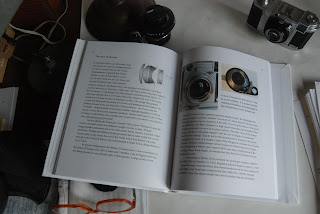 |
| Page 1 of a British patent application from 1936 |
Larry Gubas’ presentation of a patent drawing on Facebook for a light meter contained within a camera body is evidence of the changes Zeiss Ikon was considering for its various 35mm cameras. What I find interesting is that the camera type that appears in the drawings is definitely a Tenax of the Tenax II type, and not a Contax. This suggests that Zeiss Ikon intended to build the same metering system into both its Contax and its Tenax.
The evidence in the drawings: the proportions of the body, the placement of the rangefinder windows and the square viewfinder window are all pure Tenax. The shape of the lens and placement of shutter and focus levers are also Tenax. There is no way that this camera could be a Contax. But what about the famous plunger advance? The placement of the proposed meter window is certainly in the way.
For some time, a Tenax II protoype has been known in which the plunger advance has been replaced by a horizontal lever that projects from under the frame counter. It was once thought to be a prototype for the military, but with the understanding that a meter window on a Tenax III would require the repositioning of the film advance, this camera becomes evidence of how Zeiss Ikon might have solved the problem of a lever blocking a meter window. This patent drawing also is the first evidence I have seen as to what the Tenax III might have looked like had it been manufactured. While the advance would have had to be relocated, the height of the camera (and therefore, the accessories needed) would have remained the same. The camera would have remained compact and fast operation and ease-of-use would have been unaffected.
 |
| The Tenax II prototype. Picture courtesy of S. Baumgartner |
The Contax IV itself exists as a several drawings plus a number of incomplete prototypes which Gubas has shared in his book and on line. It was to be a revolutionary rather than an evolutionary product retaining only Heinz Küppenbender's vertical shutter and the external bayonet of the Contax II and III. Why?
The answer lies in patents, corporate politics and the limitations of 1930s technology. The Contax’s vertical shutter was complex and took a lot of space “under-the-hood.” Yet Küppenbender considered it his masterpiece and would not allow its abandonment. What little room was left inside was taken up by the complex internal/external lens mounting system with its built-in focusing mount, gears, sliding focusing prism and the huge bar prism that ran the width of a Contax. To maintain all this, Hubert Nerwin and his design team had to place the meter outside and on top on the Contax III. While a workable solution, it raised the height of the camera and added bulk and weight to a camera already heavier than its Leica competition. It also meant that any finders and other accessories would no longer line up in the same way as ones for the shorter Contax II. This is why there was a separate Contameter (1340) for the Contax III, as well as different masks for 85 and 135mm lenses.
The Contax IV was an attempt to solve all these problems in one complete redesign. By eliminating the built-in rangefinder system and the internal lens focusing mount, Nerwin was able to gain enough room to move the meter inside the camera, eliminating the meter hump and duplication of accessories. This also meant that all lenses would use the same mount and handle in the same way—a design imperative for Nerwin. The focusing lever and external rotating prism system that the Contax IV advocated was the same as used on the Nettax and had already proved itself on the Super Ikonta series of cameras. It promised the same focusing accuracy as the Contax, but allowed faster focusing via a lever instead of a slow-turning wheel. By continuing the use of the external bayonet mount, all external accessories would remain the same, and legacy lenses would still mount, although focusing would be by guess.
The placement of the meter window below the film advance may seem a bit strange, but it was to be in the camera but away from the rangefinder window. The left hand would now be doing the focusing for all lenses—the same as the Nettax and the Tenax II—and the right hand would remain on top of the camera for winding and shooting. All-in-all, a workable design for both the Contax and the Tenax that would fit into Nerwin’s design priorities for ergonomics and simple, intuitive handling.











